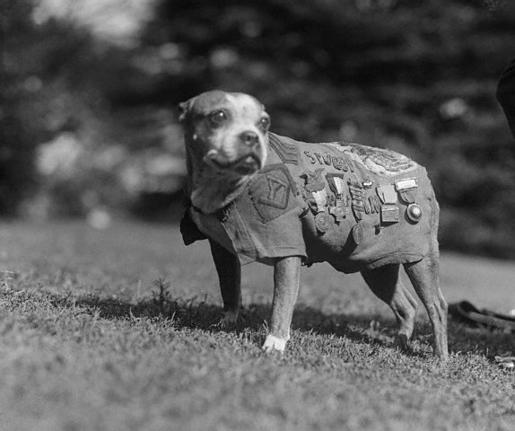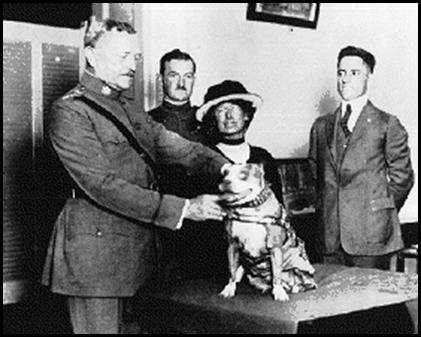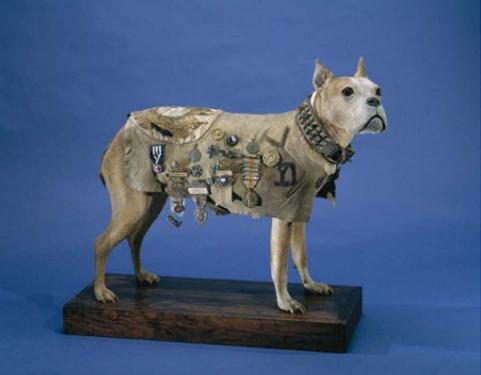Was One of the Canine Mascots for Georgetown’s Football Team a War Hero?
Here is the latest in a series of examinations into urban legends about football and whether they are true or false. Click here to view an archive of the football urban legends featured so far.
FOOTBALL URBAN LEGEND: One of Georgetown’s canine mascots was a war hero.
The first live animal mascot in college football was “Handsome Dan,” a bulldog who was purchased by Yale student Andrew Graves in 1889. The bulldog became quite popular with other Yale students and eventually became the official mascot of Yale’s football team, who were dubbed the “Bulldogs.” Yale is currently on its seventeenth Handsome Dan. While Handsome Dan is one of the most famous mascots of all-time, not even he could rival the achievements of the mascot of the Georgetown Hoyas from 1921-23, Sergeant Stubby, a true war hero!

The pit bull/terrier mixed breed puppy that would eventually be named “Stubby” entered the world in rough fashion. The dog lived off of garbage as a stray dog in his early months before being discovered on the campus at Yale University in 1917 by soldiers of the 102nd Infantry, 26th Yankee Division who were training before being sent over the Europe to fight in World War I. Private J. Robert Conroy adopted the dog who soon became a favorite among the troops. Dubbed “Stubby” because of both his short little legs and his short little tail, Conroy taught the dog to shake hands. Conroy then theorized that if he could get the dog to raise its paw to shake hands, he could get the dog to raise its paw even higher. Soon, when Conroy gave the command “Salute!,” Stubby would raise his paw in a close approximation of an actual military salute.
Conroy smuggled Stubby on to the troop transport ship headed to France. When Stubby was discovered, he charmed the superior officers enough that Conroy was allowed to keep him for “morale purposes” (the salute gag surely came in handy when it came time to charm officers). Stubby, Conroy and the rest of the 102 reached the front lines of France in February of 1918. Stubby took awhile to grow accustomed to the hellacious environment that the soldiers in the trenches were exposed to daily, with rifles and artillery fired constantly (dogs, as you might know, aren’t exactly fans of loud noises). Eventually, he grew accustomed enough to artillery attacks that he could hear incoming shells ahead of his human companions and warn them of incoming attacks.
The brave pooch suffered his first war injury when he was exposed to German gas. The rest of the men had gas masks, but although Conroy tried to use a gas mask on Stubby, he was unable to create an airtight seal and he was forced to take Stubby to a field hospital where the dog was given oxygen and eventually recovered. However, the attack left Stubby extremely sensitive to the odor of gas. This came in handy one morning later on in the war when the dog awoke the sleeping American troops with barks and nips to alert them of a surprise launch of mustard gas by the Germans. His actions helped to save the entire Division.
A month or so later, Stubby was injured in a grenade attack, being hit with a lot of shrapnel in his leg and chest. Luckily, after recovering at a Red Cross field hospital (where he cheered troops up by visiting with them), Stubby returned to duty.
During the war, there was the so-called “No Man’s Land” area between the trenches of both sides. It was dubbed this because you really did not want to be wandering out there, since the lack of cover would leave you an unprotected target for enemy snipers. It was here that trained army dogs would come in handy searching for wounded soldiers trapped in “No Man’s Land.” Stubby was trained to approach soldiers and respond to soldiers speaking English by barking loudly, alerting the Division to the whereabouts of wounded soldiers. If the soldiers were not incapacitated, he could also lead them back to the American trenches. It was on one of these missions that Stubby discovered a German spy mapping out the locations of the American trenches. Stubby approached and when the German did not respond with English, Stubby attacked, pinning the soldier down until American soldiers came by to capture the German (Stubby’s fellow soldiers had devised a military jacket for Stubby to keep the various medals awarded to him, and after he captured the German they pinned the German’s Iron Cross on to Stubby’s jacket). For capturing a German Spy, Stubby received a promotion to Sergeant. He now outranked his own master, who was by then “only” a Corporal!
After the war ended, Conroy brought Stubby back to the United States with him where Stubby was treated as a national hero. Stubby toured the country doing promotions to sell war bonds. He was given awards, took part in parades, he even met with three separate sitting U.S. Presidents (Woodrow Wilson, Warren Harding and Calvin Coolidge). For a military dog, though, perhaps his greatest honor was receiving a medal from the Humane Society that was presented to him by General John Pershing, the Commanding General of the United States Armies.

Since 1964, Georgetown University’s animal mascot has been “Jack the Bulldog” (since their team name, the Hoyas, does not translate well into a mascot). However, before they settled on Jack the Bulldog, they had a number of other canine mascots (even a Great Dane at one point), including Stubby. You see, J. Robert Conroy began attending Georgetown Law School in 1921 and he, of course, brought Stubby along. Stubby then became the mascot for the school’s football program for the length of Conroy’s time at Georgetown, doing a “halftime show” that consisted of him pushing a football around the field with his nose (when Stubby left, a terrier dubbed “Hoya” would do similar tricks).
Stubby passed away in the arms of his master in 1926. His remains are held by the Smithsonian National Museum of American History as part of its The Price of Freedom: Americans at War display (I do not believe that he is currently on public display, though. I could be wrong).

Here is a list of all the medals and honors Stubby received during his lifetime: 3 Service Stripes, Yankee Division YD Patch, French Medal Battle of Verdun, 1st Annual American Legion Convention Medal, New Haven World War I Veterans Medal, Republic of France Grande War Medal, St Mihiel Campaign Medal, Wound stripe (replaced with Purple Heart when introduced in 1932), Chateau Thierry Campaign Medal, 6th Annual American Legion Convention and the aforementioned Humane Education Society Gold Medal.
The legend is…
STATUS: True
Feel free (heck, I implore you!) to write in with your suggestions for future installments! My e-mail address is bcronin@legendsrevealed.com.





